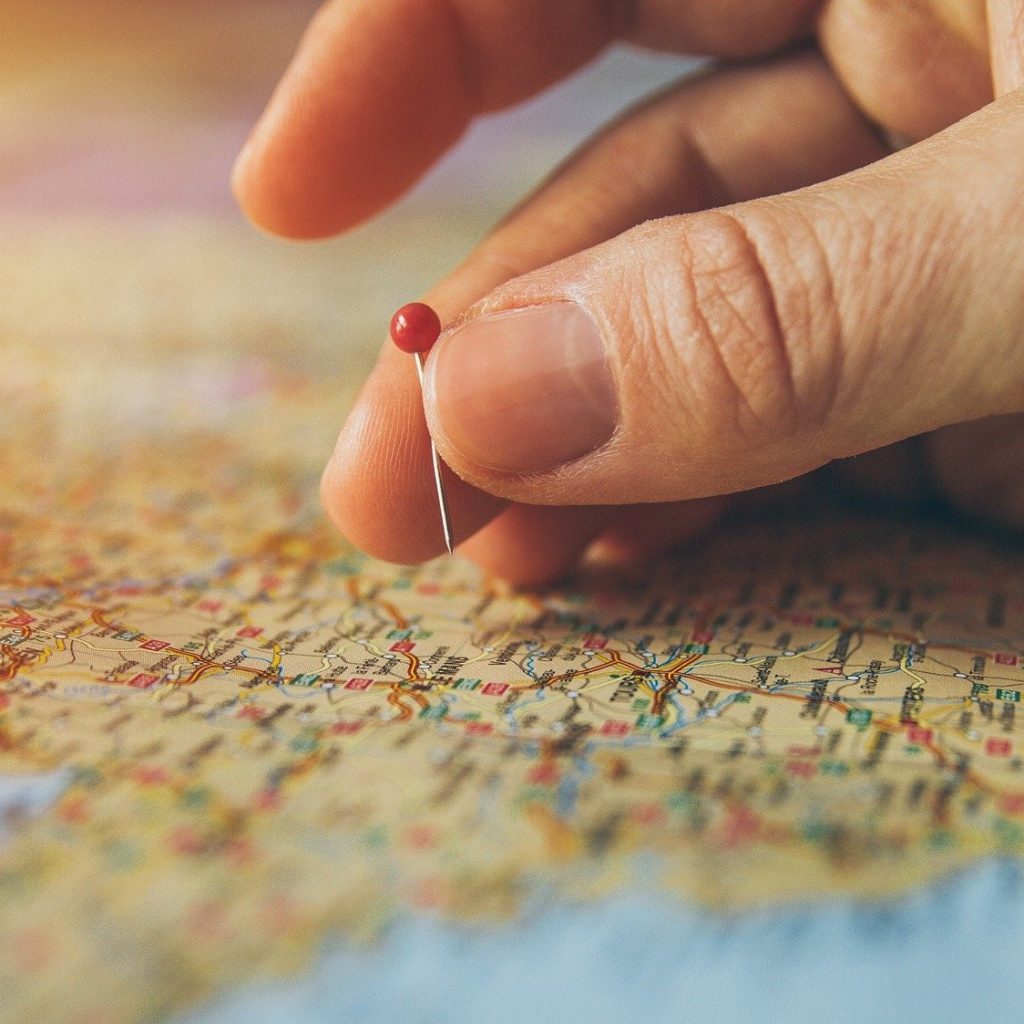Step two: where to go?
So I decided to stop making excuses and take the plunge to go on a world trip. So what now? The world is huge, and you want to see as much of it as you can. That’s what I naively thought. But so many things come into play when planning a world trip. There are some important factors to think about, like which destinations you’ll like, how long you want to stay, when, your travel pace, your budget and how to prioritize! Because in the beginning you’ll have a long list of the things you want to do. You’ll need to skip some great sites and experiences to stay within your budget and don’t get burned-out due to a fast travel pace.
You can't go everywhere!
When I decided to take off on adventure I got lost on where to begin. My plan was to visit seven continents in two years of time. Two years of traveling!! ‘l’ll be able to go everywhere and see everything!’ naively thought, as my longest trip to date was 3 weeks in the Caribbean. Well I was wrong! This is the very first thing one must realize when planning to travel long term, whether it’s a sabbatical, a gap year, a world trip or a retirement trip. You simply won’t be able to go everywhere and see everything. There are 196 countries to visit in the world. If you go one month to each country, you’ll be away for 196 months, that’s more than 16 years of traveling and it will cost you at least 300.000 euro’s. It’s simply not possible…..

…unless you have an unlimited budget and can afford to fly everywhere all the time. Otherwise you’ll need to make some decisions to prioritize and save some destinations for that next trip (and the one after that).
The biggest mistake people make when planning = planning too much.
The second step preparing a world trip was difficult for me. If you know me, you know I’m a big planner and I want to plan my time efficiently. That results in planning a lot of stuff to do and see in just as little time as possible to get the most out of my time. But if you’ve already read my page “why an around the world trip” you already know that I got burned-out in 2018/2019 because of planning and wanting too much. So, this is a big challenge for me! A world trip is different than a one- or two-week vacation. It’s very difficult to sustain the pace that most travelers have when going on vacation. Downtime is necessary, and you’ll probably travel at a much slower pace than you’re used to. Seeing site after site and traveling to new cities every few days will get old quickly. You will get burned-out at some point, no matter how quickly or slowly you travel. And if you travel at a frenetic pace, that burnout will come much quicker. You’ll need to have the time to feel at ease, to feel at home. So I did my research about a good travel pace. In my planning I’ll stay at least one month in each county. I’m a bit scared that even this pace is too fast…But I’ll see how it goes and how I’ll feel.
Obviously how much you do or don’t plan depends on a wide variety of factors, one of which is who you are traveling with. If you’re going solo, you only have yourself to worry about, so in a way, it’s a bit easier because you are the only one making decisions, and you know your own personal level of comfort. If you’re traveling as a couple or with a friend, it gets trickier. Make sure you and your traveling partner discuss how fast you think you want to move. And be sure to build in time to slow down and at least give yourself the opportunity to chill out for a bit, even if you think now that you won’t need to.

The best things happen unexpectedly
I don’t want to stay strict on my planning. I want to have room for spontaneity, because well you know, the best things happen unexpectedly. However… The first countries that are on my world trip were Russia and Nepal (due to the corona pandemic I had to change my plan). Due to strict visa obligations and the things I want to do like climbing the mount Everest (you’ll need a permit for that). It is necessary to plan this trip in advance. I made a plan for my whole world trip, but I see that more as a guide line than a strict plan. I can proceed my plan, my path, whenever I feel rested and motivated to proceed. Maybe I’ll meet someone who I’m going to travel with for a while and we make new plans along the way. Who knows….
Make a list of your top destinations
The best thing to do when first planning that long-term trip is to start researching as much as you can, open up a doc or spreadsheet on your computer (or go old school with a pen and paper), and start making lists. I worked on a word document for quite some time (over more than 2 years) to research all the things I wanted to do or see in each country that I was interested in. I read a lot of travel blogs and now I can dream about the lonely planet websites. It was fun and educational as well. I got to learn a lot about those countries, different climates and topography. Of every country I was interested in, mostly countries in Asia, Oceania and America, I made a list of my personal must see’s.
My goal is to see all seven continents. So, I definitely want to see one country in each continent. After a long research and prioritizing I came up with the next 21 places to go, in order of my planning (where I’ll start and end):
Canada – Alaska – Mexico – Guatemala – Honduras – Nicaragua – Costa Rica – Panama – Argentina – Antarctica – Chile – Peru – New Zealand– Malaysia – Thailand – Laos- Vietnam – Cambodia – Nepal – Russia – South Africa
On my travel page you can see where I’ve been (or planning to go to) and the fun things you can do there. Maybe that can help you prioritize where you want to go. Click on the regions in the map below to read more.
How about your budget?
Your first step is thinking about where to go and then going to the necessary processes of estimating how much this whole thing might cost you. While the budget is a very important piece of the puzzle, it’s not essential to have an exact number, yet. At this point, we just want to estimate. And keep in mind that any budget number you see is based on someone else’s experience. There are some who can travel Thailand on €10 per day, and some who can’t do it for under €100 per day. My estimated budget was around € 50.000,-.
I’ll go in a lot more depth on this subject in my article: ‘step four: estimate costs’. Click on the button to read more.

Set priorities
You’ll probably find out that there are so many great things to do and see over the world. It’s hard making choices and to skip great places. But unless you have all the time and money, you’ll need to cut some must-see’s.
And keep in mind if you need to skip a country, it’s not that you won’t ever see that country again. You can always go later, maybe 5-10 years later on a vacation. And besides, it won’t be any fun if you’ve seen everything already. What to do with the rest of your life, without traveling!? I hope I can get old and keep traveling as much as I can. And then I need to have some countries left over to travel to! For example a trip to the United States is also fun If you have a family – then you can go on a road trip in a motorhome for example.
But back to prioritizing the destinations for your world trip! Here are some tips that really helped me set my priorities:
- Write down your wish list: Make a document and write down all the countries you’re interested in and the things you want to do. Do some brief research about those countries and its must-see’s that you’re interested in. Maybe you’ll already find out that some of the countries you thought were interesting are not that interesting in comparison to the other countries. Maybe you can already skip some countries.
- Cross-out similar countries: There are a lot of great experiences offered in different countries, but they are quite similar. If there is more to see in another country that also offers that experience, I cut off the other country. For example in Asia: I wanted to see wild animals like elephants and tigers. That was possible in Nepal, India and Sri Lanka. I was already going to Nepal, so I cut India and Sri Lanka off.
- Cross-out off routes: Take a good look which countries/experiences are on or close to the road of your trip. If it is too far to go there, I skipped it. For example, I wanted to go to Japan as well, but it was quite far from the route I planned to take. Besides that; Japan is more expensive than other Asian countries. I decided to skip Japan, maybe I’ll go there later just for a short holiday.
- Asking yourself the following questions: When researching and prioritizing I asked myself the following questions:
- What are my top priorities? Are there experiences I've always dreamed of visiting or doing? - For me this was climbing the mount Everest and taking a boat expedition to Antarctica.
- Am I a city or cultural person, or do I prefer the outdoors? Or would I prefer to see all the best beaches in the world? I'm more of an outdoor person, but a visit to a nice beach or a cultural city is to my liking as well. But my priority is seeing the best natural spots. That's why most of the things on my to do list are UNESCO World Heritage sites.
- Do you want to volunteer, work, or take any classes while abroad? - Yes, some countries are quite expensive like Canada and New Zealand. I want to work there to lower my daily costs. But on the rest of my world trip I didn't plan to work, volunteer or take classes. I'll see if something interesting gets on my path.
- What types of accommodations do you plan on staying in (hotel, hostel, couch surfing, camping, )? - I'd like to keep my budget as low as possible, so I'll be staying in hostels most of the time.
- How do you plan on getting around? Do you want to go by plane, by public transport or your own transport (car, bicycle)? - I'll try to minimize traveling by plane as much as possible. But I can't do without, for example traveling to New-Zealand. Most of the time I'll be traveling by public transport (train or bus) and by boat.
- How much planning do you want to do in advance, and how much of your trip do you want to leave open to spontaneity? - The first countries that are on my world trip are Canada and Alaska. Due to my work as an au pair and visa obligations I needed to plan this trip well. There was little room for spontaneity, but after visiting these countries I had the freedom to open the door for spontaneity.
- Will you want to take any guided tours on your trip? Will any of your must-see destinations and activities require tours? Do any of the tours you want to take book up months in advance (you’d be surprised)? - Yes there are several destinations where a guided tour is necessary. This is for protection of the natural environment and for my own protection. For example my climb to the mount Everest is guided and I needed to book this in advance.
- Do you have a budget number in mind? - I had a good budget of € 40.000 - € 50.000. That made it possible for me to go on a big world trip!
- Check the seasons: it’s important with planning your world trip and route to keep the seasons in mind. Especially if you want to do an activity like climbing the mount Everest or taking a boat expedition to Antarctica. Those are not year-around activities. I made a list of the countries I wanted to visit and then checked when the best time is to go there. From there I could decide where I wanted to start. Some countries I needed to skip to let my planning work out for me. To read more about this subject: check my article: ‘Step 3: when to go?’
Whatever decision you make, make sure it’s you who’s making it
Your head may feel like it’s going to explode from all the information and all the great things you can do. It can be a bit overwhelming. Take your time to think about what you want and what’s possible. Write it down and narrow it down step by step. It’s important to be honest with yourself when answering these questions. Don’t feel like you have to take part in an activity you wouldn’t otherwise care about. If you don’t like camping and hiking, that’s perfectly acceptable. If you couldn’t care less about museums, that’s okay. This is your dream trip, not someone else’s – remember that.
Special thanks to Bootsnall.com for all the guidelines and information on how to plan a round-the-world trip!